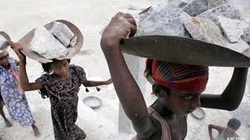This brings the shocking facts of modern slavery to the forefront.
 www.antislavery.org: cotton in Uzbekistan
www.antislavery.org: cotton in Uzbekistan According to the International Labour Organisation, nearly twenty-one million men, women and children around the world are captive. In the 21st century people are still at the complete mercy of their masters, sold like objects, and forced to work for little or no pay.
Many different points distinguish slavery from other human rights violations, however only one needs to be present for slavery to exist. Someone is in slavery if they are:
v forced to work—through mental or physical threat;
v owned or controlled, usually through real or implied mental or physical abuse;
v dehumanized, treated as a commodity or bought and sold as 'property';
v physically constrained or has restrictions placed on his/her freedom of movement.
Contemporary slavery takes various forms and affects people of all ages, gender and races.
Nowadays, bonded labor affects millions of people around the world, with biggest numbers in South East Asia. At the start, people take, or are tricked into taking, a loan for which they are unable to ever pay off. Some bonded laborers receive basic food and shelter as payment for their work, but due to penalties and rates, no matter how hard they work they are never able to pay off the loan.
 blogs.state.gov.
blogs.state.gov. Early and forced marriage predominately affects women and girls who are married without choice, forced into lives of servitude often accompanied by physical violence and have no realistic choice of leaving the marriage.
Many forms of slavery involve more than one element. For example, trafficking often involves an advance payment for the trip and organizing a promised job abroad which is borrowed from the traffickers. Once at the destination, the victims are told they cannot leave the job until the debt is paid.
How could such inequality, and, in the case of children, still exist in our world today?

 RSS Feed
RSS Feed






